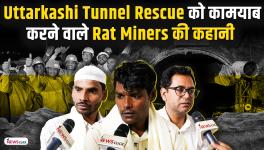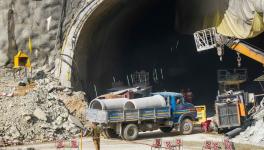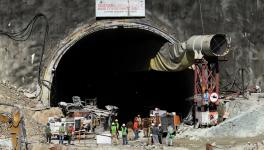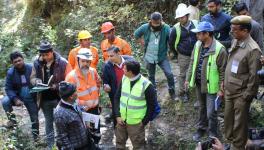Finally, a Light at the end of Silkyara Tunnel?
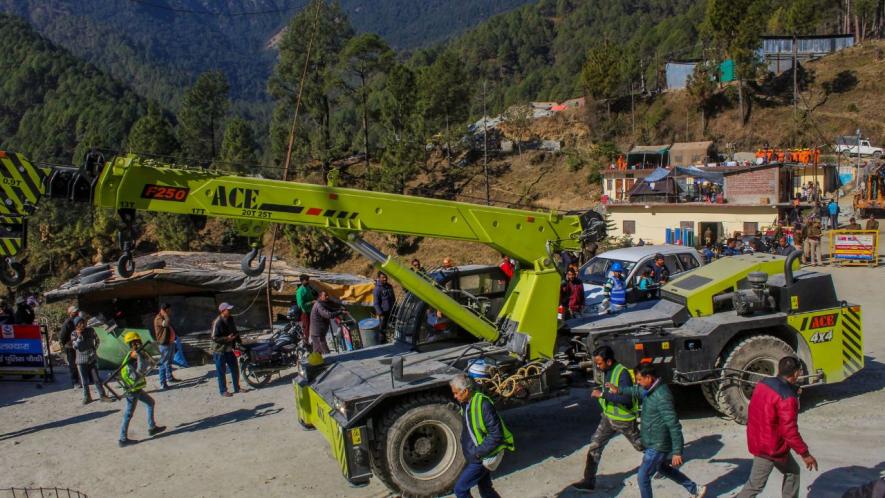
Uttarkashi: Heavy machinery near the under-construction Silkyara tunnel as drilling through the rubble to prepare an escape route for the 41 trapped workers, in Uttarkashi district, Friday morning, Nov. 24, 2023. (PTI Photo)
The 41 workers trapped in the Silkyara -Barkot tunnel for 13 days will likely be evacuated on Friday, November 24. It will be a blessing for the poor workers and their anguished families who have lived in fear of whether their loved ones will be brought out alive from this 4.5 km-long tunnel. The government put its weight behind the rescue operations, with a slew of agencies involved in the efforts, including the Prime Minister’s Office, the Indian Air Force, the National Highways Infrastructure Development Corporation Ltd, ONGC, the Defence Research and Development Organisation, the Border Roads Organisation, Rail Vikas Nigam, National Disaster Response Force, State Disaster Response Force Authority, Satluj Jal Vidyut Nigam, Tehri Hydro Development Corporation, ISRO, Geological Survey of India and several private agencies including the Trenchless Engineering Private Ltd, and the L&T Safety Unit. Yet, the accident has revealed how safety and rescue protocols were missing or inadequate in an ongoing construction in an ecologically sensitive zone.
Renowned geologist Dr CP Rajendran is an earthquake and tectonic specialist. He believes it is time for the government to review the entire development plan for the hills, considering its detrimental environmental impacts-- Edited excerpts from an interview with Rashme Sehgal.
RS: Many agencies have been drilling from three directions of the tunnel where the workers are trapped. While some drilled horizontally from the Silkyara side, others started operations from Barkot. By Tuesday, they excavated a 6.5-metre drift using the drill and blast methods. Simultaneously, the SJVNL and ONGC were to drill vertically from above the tunnel, for which a machine arrived on Tuesday. Considering the weak composition of the rocks, was the best approach adopted in your view?
CPR: I hope these methods work because human lives are involved. But a critical question is the load-bearing capacity of the rock. Too much pressure induced by drilling from two sides of the tunnel and the top should not further weaken the rocks. The work becomes extremely difficult due to soft rocks, which weaken due to crushing due to tectonic activities combined with excessive groundwater percolation.
RS: The approach seems to have been of trial and error. The bigger question is why safety norms were not operationalised, as should have happened automatically.
CPR: The Himalayas are one of the most unstable regions in the world. Underground excavations are very challenging in this region due to the fragile geology, tectonic activities and complex geological structures.
Most of the problems during tunnelling were associated with poor geology, such as shear zones, faults, folds, etc. In shear zones with highly crushed rock mass, collapses were frequently encountered. It is also found that rock bursts often occurred around the overburden of 1000 m or higher, while tunnel squeezing problems were commonly observed in a wide range of overburden. Most rock failures occurred in sheared zones, thrusts and heavily weathered rock masses.
Read Also: Anxiety Grows Around Uttarkashi Tunnel Collapse Rescue Operations
RS: The Ministry of Road Transport and Highways has ordered the National Highway Authority of India to undertake a safety audit of all 29 under-construction tunnels nationwide. But did Hyderabad-based Navajyot Engineering Company fail to provide a mandatory escape route? Why did NHAI forget to order a safety audit when the Silkyara tunnel also collapsed in 2019?
CPR: Proper site investigation is one of the major keys to successful tunnelling, in particular in the complex geological setting around the Himalayas. In this region, the subsurface analysis typically involves techniques such as Electrical Resistivity Tomography (ERT), Seismic Refraction Tomography (SRT), borehole drilling, test audits, etc. The question is whether any investigations were done before the tunnelling.
RS: Workers outside the tunnel project have told the media that NEC officials removed simple safety/escape routes like large cement pipes at the side of a tunnel.
CPR: As a norm, escape routes should have been built for long tunnels that run into kilometres. The caving-in could have been avoided; extra support should have been given at the zones identified as the loose part of the stretch. No such measures have been implemented. The experts are also of the opinion that no modern tunnelling method has been followed either in design or construction.
RS: Why are the Central and state governments unwilling to use the services of India’s vast pool of excellent and independent geologists when it comes to road construction and construction of tunnels?
CPR: It is again a trend of the times that we see much of such services being given to foreign sources. I fail to understand why the expertise available within the country is not utilised. Often, foreign experts may not have the necessary understanding of the local geological conditions.
RS: The question being asked repeatedly by scientists is why the government is pushing for tunnels in an ecologically sensitive zone, given that this is the world’s youngest mountain chain and much tectonic activity is constantly taking place here.
CPR: The active tectonic activities in the Himalayas induce the stresses that can dominate the overburden stresses resulting from gravity. However, these tectonic stresses are very difficult to assess and often overlooked during the planning stage; the practising engineers and geologists tend to measure the in situ stress only at locations deemed critical, e.g., at maximum overburden, around distressed areas or towards the valley. It is entirely possible that there are other vulnerable locations in the Uttarkashi region with very high stresses due to tectonic activities. The present government is not interested in listening to science and wants to go ahead with grandiose construction projects as a symbol of the glory and triumph of the nation as part of its nationalist agenda. What is missing in this mad rush of grandstanding is the huge price in terms of irretrievable environmental damage, loss of human lives and substantial economic drain.
RS: Should a review by NHAI also take a fresh look at the questionable validity of schemes such as building the world’s largest road tunnel connecting Dehradun to Tehri?
CPR: The government should take another look at these engineering projects in an environmentally sensitive and tectonically active region. The sequence of disasters until now is a clarion call to initiate a review of the current programme of digging and boring the mountain range of maximalist proportions. We need to follow a minimalist approach for infrastructure projects in the Himalayas, which host a dynamic and sensitive environment.
Read Also: The Char Dham Road Project is a Freeway to Disaster: CP Rajendran
RS: Several geologists have questioned whether tunnels decrease the infrastructural impact on the environment. Can you explain why?
CPR: There is a belief that building tunnels may decrease the infrastructural impact on the environment. In fact, these subsurface structures could result in gross damage to the environment, including the concentration of pollutants from traffic exhausts compounded by a micro-environment with no sunlight and limited dispersion in long-distance tunnels.
Rail traffic may constantly generate vibrations during train movements, which is another issue related to tunnels that will keep the mountain slopes eternally unstable and thus make them vulnerable to slide at the slightest trigger. Blasting to make these tunnels would often lead to weakening rock formations, further leading to landslides, besides generating vast quantities of excavated rock waste.
The irreversible impact on groundwater, such as descending water levels, has also been observed in tunnel construction areas. One example is Joshimath town, where subsidence occurred due to groundwater leakage. Tunnelling may cause impediments to groundwater. It can adversely affect the structures and influence the local ecosystem by hampering vegetation.
(Rashme Sehgal is an independent journalist.)
Get the latest reports & analysis with people's perspective on Protests, movements & deep analytical videos, discussions of the current affairs in your Telegram app. Subscribe to NewsClick's Telegram channel & get Real-Time updates on stories, as they get published on our website.










